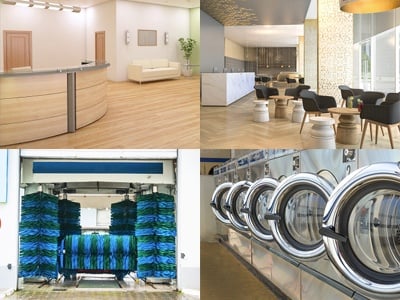Water efficiency is essential for every type of business—whether they’re water-intensive industries like healthcare facilities, hotels, carwashes or laundry services or just your standard office or retail store. But how do you formulate a comprehensive water-reduction plan that allows you to conserve water without negative business impacts?

A good place to start is with advice from the experts. Members of the Federal Energy Management Program and the U.S. Environmental Protection Agency did some brainstorming and came up with 14 best-management practices (BMPs) to improve water efficiency in a variety of settings.
These new BMPs address proper operations and maintenance for water-hogging fixtures and equipment, and also provide retrofit and replacement options. They tackle out-of-the-box options like non-potable water usage and offer concrete steps on how to assess and improve a facility’s overall water usage. Here’s a brief summary of each of the 14 BMPs:
- Water management planning. Includes a seven-step strategic plan designed to help a facility assess its current water use and costs, identify a baseline and analyze historic water use trends, determine water use for each piece of equipment, and identify leaks or other sources of water loss. The plan also helps you identify water reduction opportunities, develop an implementation plan and measure progress.
- Information and education programs. Offers suggestions on how to best communicate new water-efficiency initiatives to employees and contractors, because it doesn’t do much good if you install water-saving technology without understanding how to properly use it.
- Distribution system audits, leak detection and repair. Outlines specific steps to identify leaks and reduce water loss.
- Water-efficient landscaping. Discusses how to install and maintain Xeric plants that are appropriate for your climate zone.
- Water-efficient irrigation. Delves into topics like sprinkler timers, how to identify soil moisture levels, and high-tech sensors that provide real-time data on weather changes that affect irrigation.
- Toilets and urinals. Gives a tutorial on the different types of toilets and urinals, and how to adjust their valves and sensors to meet federal water-usage regulations.
- Faucets and showerheads. Discusses federal standards for water flow and how to meet those standards with existing or new high efficiency fixtures.
- Steam boiler systems. Outlines 11 steps on how to properly maintain these large heating devices, along with tips on how to retrofit or replace an existing system to make it more efficient.
- Single-pass cooling equipment. Applies to facilities that use CAT scanners, degreasers, hydraulics, condensers, air compressors, welding machines, vacuum pumps, ice machines or x-ray equipment.
- Cooling tower management. Discusses how air-conditioner and chiller technology works and gives tips on how to properly maintain a system and how to retrofit it in order to avoid the significant cost of replacing a cooling tower.
- Commercial kitchen equipment. Focuses specifically on water-efficient use of ice makers, dishwashers, steam cookers, pre-rinse spray valves and food disposals.
- Laboratory and medical equipment. Outlines small changes and retrofits that can improve the efficiency of water purification systems, sterilization and disinfection systems, x-ray equipment, vacuum systems, glassware washers, and vivarium equipment.
- Other water-intensive processes. Focuses specifically on laundry equipment, car washes, evaporative coolers and water softeners.
- Alternative water sources. Discusses potential applications and implementation considerations of non-potable water systems such as rainwater and storm water harvesting, graywater and other wastewater, and leftover water from water purifiers or air-handling units.
If this list seems overwhelming, start with the first three BMPs and then pick one or two more that are particularly relevant to your business. But be sure to include BMP No. 7—toilets and urinals can account for up to one-third of a business’ water use and there are many cost-effective toilet water saving devices available.






